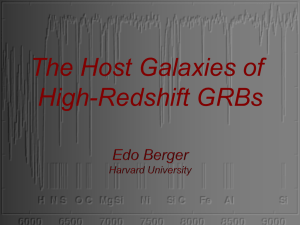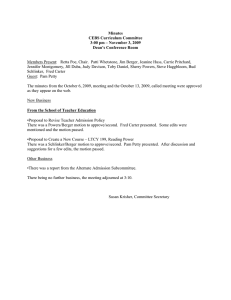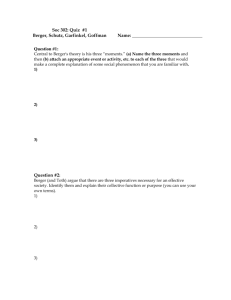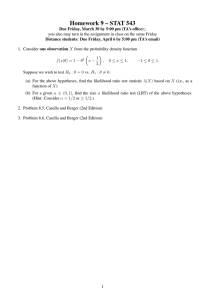GRBs and the ISM of High Redshift Galaxies
advertisement
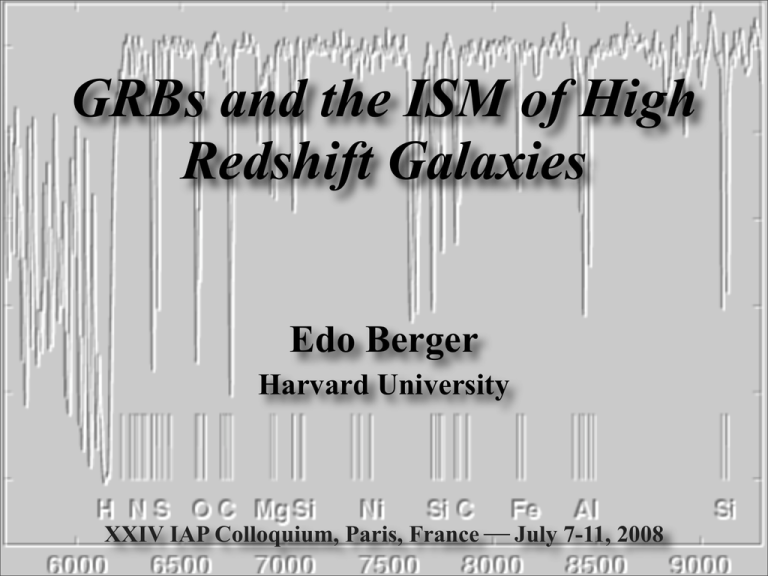
GRBs and the ISM of High Redshift Galaxies Edo Berger Harvard University XXIV IAP Colloquium, Paris, France July 7-11, 2008 1. The ISM of High Redshift Galaxies IRAC stack 2. DLA Counterparts & the Mass-Metallicity Relation at z > 2 Long GRBs = The Death of Massive Stars Association with type Ic core-collapse supernovae Mathson et al. 2003; Hjorth et al. 2003 Location in star-forming galaxies Long GRBs = The Death of Massive Stars Association with type Ic core-collapse supernovae Mathson et al. 2003; Hjorth et al. 2003 Location in star-forming galaxies Wainwright, Berger & Penprase 2007 GRB Detection and Follow-up γ-ray UV/opt. X-ray ~100 GRBs/yr with arcsec positions GRB Absorption Spectroscopy Comparison to quasars: - No Mpc proximity effect - Small impact parameter - In star forming regions - Bright(er) [ind. of z] - High(er) redshift - Power law spectrum - Fade away GRB Absorption Spectroscopy Comparison to quasars: - No Mpc proximity effect - Small impact parameter - In star forming regions - Bright(er) [ind. of z] - High(er) redshift - Power law spectrum - Fade away GRB Redshift Distribution Swift GRBs: z > 2.5: 50% z > 4: 10% z > 5: 5% zmax = 6.295 Berger et al. 2005; Jakobsson et al. 2006 GRB Redshift Distribution Chary, Berger, & Cowie 2007 Bo uw ens et a Steidel e t l. 2 00 6 al. 1999 SFRD ~ GRB × (5±2)×109 GRB Redshift Distribution Chary, Berger, & Cowie 2007 Bo uw ens et a Steidel e t Kistler et al. 2008 l. 2 00 6 al. 1999 SFH SFRD ~ GRB × (5±2)×109 SFH × (1+z)1.5 GRB Absorption Spectroscopy Berger et al. 2006 GRB Absorption Spectroscopy Berger et al. 2006 GRB Absorption Spectroscopy Berger et al. 2006 GRB Absorption Spectroscopy Berger et al. 2006 GRB Absorption Spectroscopy Berger et al. 2006 GRB Absorption Spectroscopy Berger et al. 2006 GRB Absorption Spectroscopy Berger et al. 2006 log NH =22.1 ± 0.1 [S/H] = -1.2 ± 0.1 = 0.06 Z GRB Absorption Spectroscopy GRB Absorption Spectroscopy log NH =20.8 ± 0.1 [S/H] = -1.0 ± 0.2 = 0.1 Z GRB-DLAs Berger et al. 2006; Prochaska et al. 2007; Savaglio et al. 2007 〈N(HI)GRB〉~ 10 x〈N(HI)QSO〉 GRB-DLAs MW GMCs Berger et al. 2006; Prochaska et al. 2007; Savaglio et al. 2007 〈N(HI)GRB〉~ 10 x〈N(HI)QSO〉 GRB-DLAs MW GMCs Berger et al. 2006; Prochaska et al. 2007; Savaglio et al. 2007 〈N(HI)GRB〉~ 10 x〈N(HI)QSO〉 GRB-DLAs: Abundances & Depletion Penprase, Berger, et al. 2006 GRB-DLAs: Abundances & Depletion Prochaska et al. 2007 Penprase, Berger, et al. 2006 GRB-DLAs: Abundances & Depletion Penprase, Berger, et al. 2006 more depletion Significant depletion but no evidence for dust reddening at a commensurate level GRB-DLAs: Abundances & Depletion Penprase, Berger, et al. 2006 more depletion Significant depletion but no evidence for dust reddening at a commensurate level Prochaska et al. 2007 (Absence of) Molecular Hydrogen Tumlinson et al. 2007 SMC GRB LMC QSO - Low metallicity (no dust)? - Destruction by UV radiation from the GRB? - Destruction by ambient UV radiation field? - Small numbers? (Absence of) Molecular Hydrogen Tumlinson et al. 2007 SMC GRB Whalen et al. 2008 LMC QSO - Low metallicity (no dust)? - Destruction by UV radiation from the GRB? - Destruction by ambient UV radiation field? - Small numbers? ~1-10×IMW GRB-DLA Host Galaxies GRBs offer an alternative galaxy-selection technique Redshifts & metallicities measured from absorption spectra GRBs What is the connection between DLAs and star formation? z>1 Surveys Blanton et al. 2003 QSO-DLA Counterparts Colbert & Malkan 2002 DLA? 3’’ ~ 25 kpc QSO HST/NICMOS [H(5σ)=22 mag; 1/22 detected] Most DLAs are not drawn from the bright end of the LBG population L* ± 1 mag QSO-DLA Counterparts Colbert & Malkan 2002 DLA? HST/NICMOS [H(5σ)=22 mag; 1/22 detected] Warren et al. 2001 3’’ ~ 25 kpc QSO Most DLAs are not drawn from the bright end of the LBG population L* ± 1 mag GRB-DLA Counterparts GRBs have <1″ offset no ambiguity about which galaxy is the DLA counterpart GRBs fade away galaxy can be imaged to L L* & regardless of PSF GRB-DLA Counterparts z = 3.372 Vreeswijk et al. 2004 GRB-DLA Counterparts z = 3.372 Vreeswijk et al. 2004 HST/ACS 1″ = 7.5 kpc Wainwright, Berger et al. 2005 F606W(AB) ≈ 28.1 mag L ~ 0.02 L* SFR ~ 1 M⊙/yr } Too faint for other techniques No spectroscopic confirmation GRB-DLA Counterparts Chary, Berger, & Cowie 2007 z = 4.942 Fν = 0.23±0.04 µJy LV ≈ 1.3×1010 L ~ 0.15 L* [S/H] = -0.85±0.20 = 0.15 Z GRB-DLA Counterparts Chary, Berger, & Cowie 2007 Chary, Berger, & Cowie 2007 z = 4.942 Fν = 0.23±0.04 µJy LV ≈ 1.3×1010 L ~ 0.15 L* [S/H] = -0.85±0.20 = 0.15 Z GOODS The Mass-Metallicity Relation at z > 3 Chary, Berger, & Cowie 2007 z ~ 5-6 z ~ 5-6 z ~ 0: Tremonti et al. 2004; z ~ 1: Kobulnicky & Kewley 2004; Savaglio et al. 2005; z ~2: erb et al. 2006 Obscured Star Formation Berger, Cowie, et al. 2003 VLA 8.5 GHz z = 1.119 R = 23.5 mag R−K = 2.2 mag SFRopt = 55 M⊙/yr Berger et al. 2001 VLA 8.5 GHz z = 0.966 R = 22.4 mag R−K = 2.8 mag SFRopt = 10 M⊙/yr Obscured Star Formation Berger, Cowie, et al. 2003 Berger et al. 2001 VLA 8.5 GHz z = 1.119 R = 23.5 mag R−K = 2.2 mag SFRopt = 55 M⊙/yr SFR ~ 100-300 M⊙/yr LFIR ~ (1-3)×1012 L⊙ VLA 8.5 GHz z = 0.966 R = 22.4 mag R−K = 2.8 mag SFRopt = 10 M⊙/yr Obscured Star Formation SCUBA VLA Berger, Cowie, et al. 2003 - ~10% detection rate in radio/submm - SFR ~ 100-300 M⊙/yr - Detected hosts are LIRGs/ULIRGs but very blue Cosmic Re-ionization Gnedin et al. Fan et al. 2006 xH > 3x10-4 ⇐ GRBs and Cosmic Re-ionization z = 6.295 log NH ~ 21.3 Z ~ 0.05 Z Kawai et al. 2005 GRBs and Cosmic Re-ionization z = 6.295 log NH ~ 21.3 Z ~ 0.05 Z Kawai et al. 2005 GRBs and Cosmic Re-ionization z = 6.295 log NH ~ 21.3 Z ~ 0.05 Z τ ~ 105 Kawai et al. 2005 xH < 0.6 τ~1 Summary - Long GRBs are the end product of some massive stars - GRBs have been detected to z ~ 6.3 - Afterglow spectroscopy reveals DLAs in ~90% of the cases - The HI columns and metallicities are on average higher than in QSO-DLAs - Evidence for depletion in the warm ISM of the hosts but with no commensurate extinction - The availability of precise positions and the declining flux allow deep searches for DLA countparts - Initial observations with Spitzer reveal counterpart with ~0.1 L* - Some GRB hosts have highly obscured star formation
